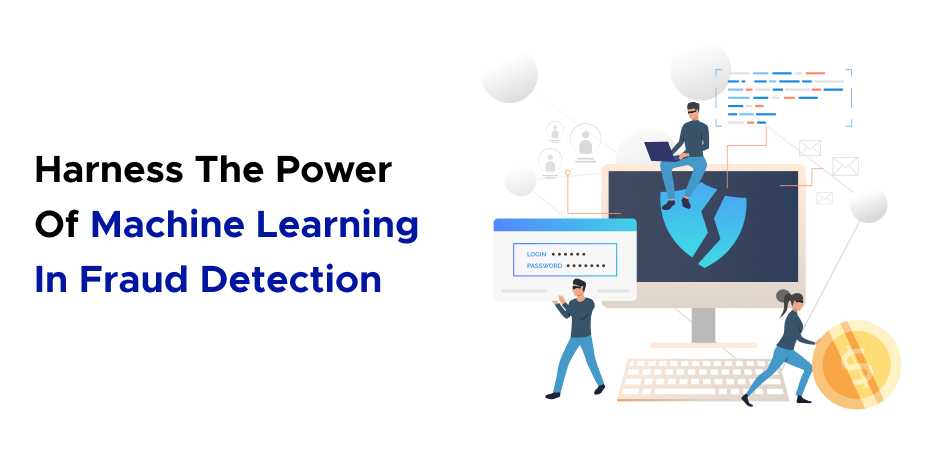7 Apr 2025
8 Common Mistakes in ML-Based Fraud Detection
Shaun Bell

Fraudsters are cockroaches—when you think you’ve crushed them, they have another way of crawling back. But what if your defense were not only reactive but also competent? That is precisely what ML-based fraud detection offers—a continuously learning digital guard that picks up on patterns, anticipates suspicious activity, and halts fraud. A dedicated machine learning app development company can help you transform your unique ideas into a strategic approach to developing a high-performing application.
For quality assurance mobile app companies, particularly those in fintech, e-commerce, and mobile apps, fraud is not just a nuisance—it’s a direct blow to the bottom line and brand. That’s where a high-quality machine learning app development firm can be the game-changer, embedding machine learning-based security into your apps. No more static rule-based anti-fraud systems; AI-powered models now inspect real-time user behavior, catching anomalies before they lead to losses.
Smarter Security: How ML Shields Your App from Fraud
Envision an app that recognizes when a login is suspect, detects when a transaction is “off,” and responds before fraud artists can act. That’s the magic of ML, and the appropriate machine learning app development firm can assist you in integrating it naturally into your digital environment. From biometric authentication to anomaly detection to predictive security, machine learning is revolutionizing fraud prevention for mobile apps.
In a world where cybercrooks are becoming increasingly clever, your defenses must be more intelligent. Collaborating with quality assurance mobile app development companies that know ML-powered security isn’t merely a sound decision—it’s your best strategy in the online war. So, are you prepared to outwit the scammers? Because your app sure should be.
What Is Machine Learning? How Can Machine Learning App Development Help in Fraud Detection?
Understanding Machine Learning
Machine learning is the underlying power for intelligent automation, predictive analytics, and advanced security solutions. Machine Learning represents AI’s subset, which teaches computers to detect patterns inside data and make autonomous choices through automated learning processes. The ML algorithm system develops through continuous self-improvement, leading to better accuracy rates.
Organizations involved in finance operations, e-commerce services, and mobile application businesses must actively address fraud threats because they present a serious operational concern. Current security protocols prove inadequate, so businesses have started using machine learning systems in fraud detection to combat cybercriminals effectively.
Start-up mobile app development companies can embed innovative machine learning app development services to enhance security within their applications through their integration efforts.

How Can It Help In Fraud Detection?
Machine Learning boosts the capabilities to detect fraudulent activities through various methods.
ML advances at a pace that matches and exceeds the intelligence level of fraudsters. A fraud detection system works in the following three ways:
1. Real-Time Anomaly Detection
ML models run at such high speeds that they process millions of transactions per second before finding atypical patterns. Thankfully, the system monitors unexpected behavior, such as significant transactions and non-standard location access by users, to alert them about possible deception.
2. Predictive Analysis
ML examines past data to forecast fraudulent actions in advance. The system can identify early warning signals that enable business protection against fraud by analyzing historical fraud attempts instead of traditional reactive measures.
3. Behavioral Biometrics
The ML technology measures behavioral characteristics that define users’ interaction methods by monitoring their typing speed, swipe patterns, and device operating patterns instead of using only passwords. The system initiates a security measure when any account displays abnormal behavior.
4. Adaptive Security Measures
The system differs from conventional rule-based systems because ML-driven fraud detection undergoes continuous adaptation. The system uses fresh insights from fraudulent practices to maintain application and system superiority compared to cyber attacks.
10 Common Mistakes in Machine Learning
The transformation of industries by machine learning (ML) applies to healthcare along with mobile applications, and ERP Software in Oil and Gas. Using ML leads to incorrect predictions as well as reduced operational effectiveness. The investigation of AI system errors enables artificial intelligence app development companies to create better AI-based solutions. The partnership with a determined machine learning app development firm allows effortless integration of ML that leads to better performance and reduces implementation risks. This article presents ten typical mistakes in ML together with their remedy approaches.
1. Insufficient and Poor-Quality Data
The success of ML models depends on using outstanding quality data. Inaccurate and unreliable predictions occur when researchers utilize micro, one-sided, or incomplete datasets. Most businesses fail because the data they collect cannot accurately represent the conditions of the actual business environment. Working with dependable start up mobile app development companies enables organizations to obtain better data sources that enhance model accuracy and eliminate biases to make precise decisions through applications. Developing machine learning applications helps create data analysis systems which maximize the utilization of collected information to enhance outcomes of prediction and decision-making.
How to Avoid It:
Collect diverse and representative data.
The first step should involve cleaning up raw data before applying necessary preprocessing methods to eradicate errors and inconsistencies.
Technical data sampling methods help increase training dataset sizes.

2. Ignoring Data Preprocessing
Immediate use of raw data leads to incorrect model performance because it contains various errors, missing value types, and data inconsistencies. Irritating preprocessing procedures cause models to learn artificial data patterns that do not reflect actual conditions. Three data preprocessing techniques- normalization, standardization, and missing value handling- enhance the quality of the collected data.
An expert machine learning application development company establishes suitable preprocessing protocols to generate orderly datasets, which result in better functionality within mobile applications and AI-powered systems.
How to Avoid It:
- Normalize or standardize numerical features.
- The technique of imputation should be used to handle data gaps.
- Outlying teaching points should be removed because they distort the learning process.
3. Overfitting the Model
An ML model develops overfitting behavior when it learns training data directly instead of detecting patterns. Such variations affect the model score on training sessions while producing inferior results when used on fresh datasets. To avoid overfitting, the model utilizes three mechanisms – cross-validation with regularization function and dropout layers.
A skilled mobile application development company completes model optimization to establish generalizable patterns that result in dependable and precise predictions that work consistently across diverse actual world situations.
How to Avoid It:
- Implement cross-validation together with dropout layers as part of the algorithm.
- New data collection should be performed to achieve better generalization results.
- The simplification of complex models should occur before adding extra parameters becomes necessary.
4. Underfitting the Model
A simple model becomes underfitting when it does not identify essential patterns within the dataset. Such errors lead to poor testing and training outcomes because the model cannot predict data accurately. The solutions for this issue include adding more complex features to the model, fine-tuned hyperparameter values, and longer training durations. An expert machine learning app development company helps models find proper complexity levels to ensure generalized results and optimized AI performance.
How to Avoid It:
- Model execution requires enhanced complexity by adding more features and layers to the system.
- Appropriate training duration for more epochs must be implemented.
- Select an ML algorithm that matches the requirements of the current task.
5. Improper Feature Selection
It decreases model accuracy and efficiency due to irrelevant or redundant features. Poor feature selection requires extra computation time and performance, and results are reduced from feature selection techniques like Recursive Feature Elimination (RFE) or Correlation Analysis. A famous flutter mobile app development company adds value to the feature definitions, ensuring that ML models are focused on things that matter and derive better insights. Developing machine learning applications allows organizations to optimize the use of gathered data for better prediction and decision-making outcomes.
How to Avoid It:
- The RFE (Recursive Feature Elimination) technique should be used to select features.
- You should conduct a correlation test to detect multiple features that present duplicate information.
- Automated software tools are used to generate new features automatically.
6. Absence of Hyperparameter Tuning
Default hyperparameters don’t generally give optimal results. This leads to suboptimal performance and inefficiency. Model performance can be enhanced through Grid Search, Random Search, and Bayesian Optimization techniques. A trusted machine learning app development company fine-tunes the hyperparameters to ensure that maximum efficiency from an ML model can be realized for all possible applications of mobile and AI-driven platforms.
How to Avoid It:
- Grid search and random search methods should be applied for hyperparameter optimization.
- Bayesian Optimization serves as an automated optimization tool for the process.
- System parameters should be revised according to actual field performance metrics.
7. Not Considering Model Interpretability
Many ML models act as so-called “black boxes” so that only some decisions can be clear regarding them—lack of interpretability results in trust issues, especially in finance and healthcare. Efficiency is introduced through explanation methods including c SHAP and LIME (Local Interpretable Model-Agnostic Explanations). It is ensured that any AI solution is explainable and regulatory compliant by a popular flutter mobile app development company, thus weaving end-users’ trust.
How to Avoid It:
- Decision trees and Linear Regression serve as optimal models because of their interpretability.
- You should use the SHAP (Shapley Additive Explanations) and LIME (Local Interpretable Model-Agnostic Explanations) techniques for model explanation.
- The supervision of operations must remain visible when processing data in regulated marketplaces.

8. Ignoring Model Deployment Challenges
Creating an ML model is entirely different from using it in an application. Most developers face problems when it comes to integrating those models into an application so that it does not cause inefficiency. No particular device has been assigned for mobile deployment by such architectures, like optimizing multiple inference operations under the mobile TensorFlow Lite, which lowers the application overheads.
A good app development company will work towards integrating systems embedded with ML technology within the app, ensuring a good overall user experience with security and low regard for the app’s performance. The application gains smarter capabilities through machine learning in mobile app development periods to become more responsive for user needs while performing functionally optimally.
How to Avoid It:
- Work with an established machine learning app development company that will handle integration tasks successfully.
- The mobile deployment of ML models requires a TensorFlow Lite framework for optimized model implementation.
- Your models should get updated through continual feedback from the real world.
9. Neglecting Model Monitoring and Maintenance
The models become stale with time because changes in data patterns cause a drop in accuracy. Monitoring can be done regularly to identify early performance declines. Regular updating and retraining of a model prevents model drift. According to a determined Android app development company, an automated monitoring tool will take into account the tracking of model performance to ensure its long-term efficiency and adjustment to changes in the behaviors of users.
How to Avoid It:
- A/B testing should be used to examine model performance perpetually.
- Model training must be conducted regularly through updates with new data sets.
- The system should trigger automatic notifications whenever performance declines occur.
10. Fail to Align ML Goals with Business Objectives
Many businesses apply ML without a concrete objective, resulting in a waste of resources. Aligning ML strategies with business goals improves decision-making and return on investment. KPIs like fraud detection accuracy and user engagement should be among the considerations. A competent Android mobile app development company ensures ML solutions are customized for business purposes, maximizing value while driving application innovations.
How to Avoid It:
- You should collaborate with a great iPhone mobile app development company to establish ML goals.
- The mobility solution must match business performance indicators by meeting goals for fraud detection effectiveness and user interaction metrics.
- An ongoing review of ML strategies should be performed to maintain their usefulness.
Benefits Of Using ML In Fraud Detection
Fraud detection is one of organizations’ most significant challenges, especially concerning financial transactions, e-commerce, and mobile applications. All these developments are coupled with the increase in online fraud, making security measures no longer effective. Machine Learning (ML) brings futuristic capabilities to detect and prevent fraud with real-time detection and prevention features. This is an added security measurement to client trust when a dedicated Android mobile app development company integrates ML-based fraud detection into apps.
1. Real-Time Fraud Detection
One of the paramount advantages of ML in fraud detection is the capability to process transactions in real-time. Whereas traditional rule-based systems are more reactive than proactive, ML models simulate detection from massive datasets. Through these measures, artificial intelligence mobile app development companies can prevent upcoming fraudulent transactions from occurring. When developing machine learning applications, data collection methods ensure proper data utilization for enhanced forecasting and choice-making capabilities.
2. Increased Accuracy and Efficiency
The algorithms learn nonstop; thus, they use past data to their advantage whenever they detect it. This approach decreases the occurrence of legitimate transactions wrongfully marked as fraud and the missed detection of actual fraud operations. The enhanced accuracy and operational effectiveness enable businesses to deliver smooth transactions with machine learning app development services to their customers.
3. Flexibility to Novel Types of Fraud with Machine Learning App Development
The continued evolution of fraudsters’ techniques makes it impossible for traditional security systems to keep up with the changes. However, the detection of new fraud patterns for ML models is possible without the need for constant manual updating. A competent iPhone mobile app development company can integrate such adaptive ML models into different applications, safeguarding them from new types of fraud. Historically machine learning in mobile app development to gain extra capabilities which produce heightened responsiveness to users combined with sustainable operational standards.

4. Cost Cutting in Fraud Prevention Measures
Fraud losses are very high for any business. This is why they lessen the cost of losses due to ML-based fraud detection in the early identification of fraud, prevention from chargebacks, and loss minimization. Automation gives users greater security through reduced operational costs of manual review teams and delivers cost-saving capabilities.
5. User Friendliness
Security measures present a difficulty in fraud prevention because they must coexist with user convenience. Through machine learning tools for fraud detection, people receive better security protection without losing convenient machine learning app development services, so their transactions keep running smoothly. Real-time anomaly detection through ML analysis prevents malicious transactions without stopping valid customers from using the system for secure and confident transactions.
6. Scalable and Future-Proof Security
As businesses expand, so does their transaction volume. With no limits, fraud detection would quickly scale with an increase brought about by tremendous amounts of data. As such, effective for organizations with growth in digital footprint and expansion, a reliable UI UX app development company could merely future-proof their applications by integrating these ML-driven solutions into security.
Key Challenges of Using Machine Learning in Fraud Detection and Machine Learning App Development
Through its revolution, machine learning has brought businesses better fraud detection through accelerated and precise identification of fraudulent activities. Various challenges accompany implementing ML-based fraud detection systems despite their numerous advantages. A determined machine learning application development company aiming to add ML-driven fraud prevention systems to their software must address these obstacles to obtain proper implementation results.
1. Data Quality and Availability
Main Language models need good-quality data for precise fraud pattern detection. The data available to businesses typically includes problems such as insufficient information irregularities and intentional data manipulation. Data lacking quality produces wrong fraud predictions, resulting in false positives and negatives. Progressive web app development companies need full access to well-structured datasets with diverse contents to implement fraud detection effectively.
2. Evolving Fraud Techniques with Machine Learning App Development
Security measures function as a temporary barrier because fraud perpetrators resolutely alter their schemes to get through them. The ability of ML models to recognize known fraud patterns does not extend to the discovery of new fraud techniques. Regular model updating and training are necessary to stay ahead of developing fraud schemes, but this makes the fraud detection process financially demanding for social networking mobile app development companies.
3. High Implementation Costs
Machine learning app development firms must spend significant resources on infrastructure, skilled staff, and continuous model upgrades to develop and keep ML-based fraud detection systems active. Some progressive web app development companies, small businesses, and medium-sized enterprises find advanced fraud detection technologies unaffordable for their business models. Implementation of machine learning in mobile app development makes programs perform smarter with improved user-responsive capabilities while preserving their operational capabilities.

4. False Positives and Negatives
Accurate performance by an ML model is essential in identifying fraud, but most organizations struggle to reach complete precision levels. Commercial transactions falsely identified as fraudulent by detection systems produce user frustration and negatively impact business reputation, but undetected genuine fraudulent activity results in financial losses. The reduction of errors in models needs ongoing tracking and continuous improvement. Developing machine learning applications allows organizations to optimize their use of gathered information for better predicative and decision-making outcomes.
5. Regulatory and Compliance Issues
Financial institutions and healthcare organizations must follow strict compliance standards when implementing fraud detection programs. All ML systems must fulfill data privacy regulation requirements, including GDPR, CCPA, and national data restrictions. Cross-platform mobile app development companies must abide by these legal frameworks for integrating fraud detection in applications since non-compliance leads to penalties.
6. Interpretability and Transparency
Deep learning-based models, alongside several other ML models, operate as “black boxes” because humans cannot easily understand their decision-making processes. Organizations and regulatory bodies demand transparent artificial intelligence to validate fraudulent detection outcomes. Developing transparent models that are accurate is a complex task. Through machine learning app development services organizations can develop clear models with high performance along with increased reliability.
Future of Machine Learning App Development in Fraud Detection
1. Predictive Analytics
Machine learning models will keep advancing to identify fraudulent activities during their planning stages; therefore, businesses can take preemptive security measures. The analysis of vast dataset usage by ML algorithms enables the detection of suspicious patterns and abnormal activities indicating fraud. Social networking mobile app development companies will experience reduced losses and keep their customers financially safe through these new detection methods.
2. AI-Powered Behavioral Analysis with Machine Learning App Development
Solution performance will advance by continuously tracking user activity patterns. To find abnormal conduct, AI systems will monitor user interactions, including login patterns, purchasing records, and device activity patterns. This method allows a commendable machine learning application development company to deploy immediate fraud prevention systems that enhance mobile application security. The implementation of machine learning in mobile application development brings artificial intelligence that enables improved performance together with enhanced accuracy in meeting application requirements.
3. Adaptive Authentication
The security protocols adjust their protection measures for user experience convenience based on the identified risk levels. The assessment from ML-based systems will use user actions context, including geolocation data, device fingerprinting information, and transaction history, to establish needed authentication levels. Security detection will be elevated by preserving usability features supporting finance sector operations and developing e-commerce and mobile apps.

4. Deep Learning for Anomaly Detection
Through deep learning models, fraud detection systems will achieve superior accuracy by processing advanced multidimensional dataset structures. Neural networks can detect secretive fraud indicators that traditional models typically miss to identify. Deep learning emerges as an essential tool to fight new fraud techniques that criminals continuously develop.
5. Integration with Mobile Applications
Flawless ML-based security solutions need implementation within mobile applications by a dependable machine learning application development company to fight fraud cases. App users feel more secure when strong fraud prevention systems protect their data inside the application. A dependable machine learning app development company can utilize AI analytical tools to deliver fraud prevention solutions customized for particular industries.
Conclusion
Real-time security solutions empower Machine Learning (ML) to adapt its fraud detection methods against developing threats. The market expansion of digital transactions enables attackers to create unique techniques that outstrip conventional security systems. Fraud detection accuracy increases through ML by examining patterns and detecting abnormalities while preventing unwarranted alerts.
Cross-platform mobile app development companies can implement ML-driven fraud prevention systems to deliver secure user experiences to their customers. The security features implemented in mobile applications rely on biometric identification, behavioral monitoring, and AI technology to assess risks. App development companies looking towards the future implement ML to automate fraud detection, resulting in quicker response times and less need for human intervention.
Continuous improvements in Machine Learning technology represent the key factor for fraud detection development. A dedicated UI/UX mobile app development company should prioritize AI-driven security solutions to protect user trust and manage emerging threats successfully. Businesses achieve safe digital environments by implementing practices that support transactional efficiency.








